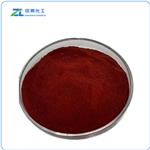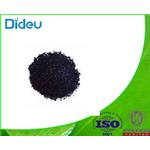Description
Bulnesia sarmienti Lor. is a wild tree 3 to 4 m (10 to 13 ft.) high,
widespread in the woods of Argentina and in the Gran Chaco area
of Paraguay. This variety yields the true guaiac, Guaiacum officinale
L., also a tree native to tropical America (Caribbean Islands),
grows wild or cultivated in Venezuela, Jamaica, Cuba, and Colombia.
This variety yields a resinous substance from which a tincture
is prepared. The wood and sawdust from the tree are the parts
used. Guaiac has a soft, pleasant, rose-like odor reminiscent of tea
roses.
The essential oil is obtained by steam distillation of chipped wood
of B. sormienti in approximately 3% yields. It is a thick, viscous,
orange-brown mass with a woody, rose-like odor reminiscent of
tea rose. Sometimes the oil exhibits a smoky note. The main
constituent of the oil, also known as champaca wood oil, is guaiol,
a sesquiterpene alcohol (85%).
The derivatives are fluid extract, tincture (mainly from G. officinale
L.). The tincture is generally a 10% solution in 60% ethanol. The
fluid extract is a reddish-brown liquid with a pleasant odor and
burning, bitter taste.
Chemical Properties
Brownish lumps. Mp 85C. Insoluble in
water; soluble in alcohol, ether, acetone, chloroform,
and caustic soda.
Chemical Properties
Bulnesia sarmienti Lor is a wild tree 3 to 4 m high, widespread in the woods of Argentina and in the Gran Chaco area of Paraguay This variety yields the true guaiac G offcinale L , also a tree native to tropical America (Caribbean Islands), grows wild or cultivated in Venezuela, Jamaica, Cuba and Colombia This variety yields a resinous substance from which a tincture is prepared The gum occurs as irregular masses enclosing fragments of vegetable tissues, or in large, nearly homogeneous masses and occasion- ally in more or less rounded or ovoid tears The wood and sawdust from the tree are the parts used Guaiac has a soft, pleasant, rose- like odor reminiscent of tea roses and a slightly acrid taste.
Physical properties
Externally, the gum is brownish-black to dusky-brown, acquiring a greenish color on long expo- sure; the fractured surface has a glassy luster The thin pieces are transparent and vary in color from brown- to yellowish-orange The powder is moderate yel.
Uses
Clinical reagent (blood or hemoglobin).
Uses
The Nobles test can be performed using 67% (w/v) gum guaiac diluted in 96% ethanol to analyze the level of extracellular oxidase production
Definition
A resin from certain Mexican and West Indian trees, especially Guaiacum santum and G. officinale.


